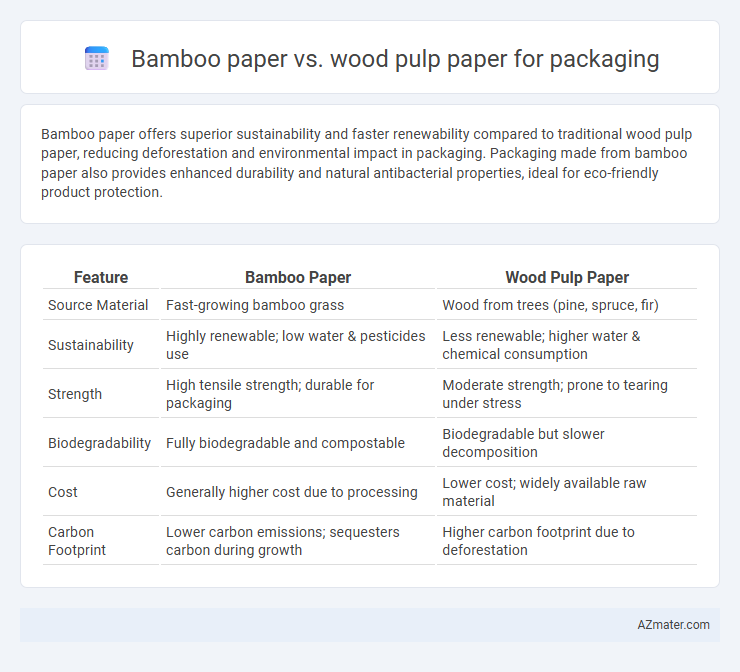Bamboo paper offers superior sustainability and faster renewability compared to traditional wood pulp paper, reducing deforestation and environmental impact in packaging. Packaging made from bamboo paper also provides enhanced durability and natural antibacterial properties, ideal for eco-friendly product protection.
Table of Comparison
| Feature | Bamboo Paper | Wood Pulp Paper |
|---|---|---|
| Source Material | Fast-growing bamboo grass | Wood from trees (pine, spruce, fir) |
| Sustainability | Highly renewable; low water & pesticides use | Less renewable; higher water & chemical consumption |
| Strength | High tensile strength; durable for packaging | Moderate strength; prone to tearing under stress |
| Biodegradability | Fully biodegradable and compostable | Biodegradable but slower decomposition |
| Cost | Generally higher cost due to processing | Lower cost; widely available raw material |
| Carbon Footprint | Lower carbon emissions; sequesters carbon during growth | Higher carbon footprint due to deforestation |
Introduction: The Rise of Sustainable Packaging Solutions
Bamboo paper offers a rapidly renewable alternative to traditional wood pulp paper, significantly reducing deforestation and carbon emissions in packaging production. Its natural durability and biodegradability make it an ideal choice for eco-conscious brands aiming to minimize environmental impact. With bamboo's faster growth cycle compared to trees, this material supports sustainable packaging solutions that meet increasing consumer demand for green products.
What Is Bamboo Paper?
Bamboo paper is made from fibers of the fast-growing bamboo plant, offering a sustainable alternative to traditional wood pulp paper used in packaging. Its production requires fewer chemicals and less water than wood pulp, resulting in a more eco-friendly and biodegradable material. Bamboo paper provides comparable strength and durability, making it ideal for packaging solutions focused on sustainability and environmental impact reduction.
What Is Wood Pulp Paper?
Wood pulp paper, derived from mechanically or chemically processed wood fibers, serves as a primary material for packaging due to its strength and versatility. It typically contains a high percentage of cellulose extracted from softwood or hardwood trees, making it suitable for various packaging applications such as boxes, bags, and wrapping. Compared to bamboo paper, wood pulp paper usually has a more established recycling infrastructure but may involve more intensive resource usage and longer growth cycles.
Raw Material Sourcing and Environmental Impact
Bamboo paper for packaging is sourced from fast-growing bamboo plants that regenerate within 3-5 years, compared to wood pulp paper derived from slow-growing trees that take decades to mature, making bamboo more sustainable. The environmental impact of bamboo paper is lower due to its reduced need for fertilizers, pesticides, and water, along with higher carbon sequestration during growth. Wood pulp paper production often involves deforestation and higher energy consumption, contributing to greater greenhouse gas emissions and habitat loss.
Production Process Differences
Bamboo paper production utilizes fast-growing bamboo stalks that require less water and fewer chemicals during pulping compared to traditional wood pulp paper, which is derived from slow-growing hardwood or softwood trees needing intensive mechanical and chemical treatments. The bamboo pulping process typically involves mechanical or semi-chemical methods that preserve fiber strength and enhance biodegradability, while wood pulp production relies heavily on kraft or sulfite pulping, generating more harmful effluents and higher energy consumption. These differences contribute to bamboo paper's lower environmental impact and increased sustainability in packaging applications.
Strength and Durability Comparison
Bamboo paper exhibits superior tensile strength and tear resistance compared to traditional wood pulp paper, making it an ideal choice for packaging that demands durability. The natural fibers in bamboo are longer and more robust, contributing to enhanced resistance against moisture and mechanical stress during transit. Consequently, bamboo-based packaging ensures better protection and longevity, reducing the risk of damage and improving overall product integrity.
Biodegradability and Compostability
Bamboo paper for packaging offers superior biodegradability due to its natural fiber composition, breaking down faster in composting environments compared to conventional wood pulp paper. Wood pulp paper, while also biodegradable, often contains chemical additives that can slow decomposition and reduce compost quality. Choosing bamboo paper enhances sustainable packaging efforts by providing a compostable alternative with lower environmental impact and quicker return to the ecosystem.
Cost Efficiency and Economic Factors
Bamboo paper offers a more cost-efficient alternative to wood pulp paper for packaging due to its faster growth cycle and higher yield per acre, reducing raw material expenses significantly. The economic benefits extend from lower production costs and reduced reliance on timber, which faces volatility in supply and pricing. Companies adopting bamboo paper achieve improved sustainability metrics while maintaining competitive pricing, making it an attractive choice for eco-conscious packaging solutions.
Market Trends and Consumer Preferences
Bamboo paper packaging is gaining significant market traction due to its sustainability and fast renewability, offering a lower environmental footprint compared to traditional wood pulp paper, which relies on slower-growing hardwood forests. Consumer preferences are shifting towards eco-friendly materials, with increasing demand for biodegradable and reusable packaging solutions driving the bamboo paper market growth. Market analysis reveals that companies adopting bamboo paper are positioned to capitalize on regulatory pressures and consumer advocacy for sustainable packaging alternatives.
Conclusion: Which Paper is Better for Packaging?
Bamboo paper offers superior sustainability with faster regrowth rates and lower environmental impact compared to traditional wood pulp paper, making it an eco-friendly packaging choice. Wood pulp paper remains widely used due to its established supply chains and cost-effectiveness but often involves deforestation and higher carbon emissions. Considering durability, renewability, and ecological footprint, bamboo paper is generally the better option for environmentally conscious packaging solutions.

Infographic: Bamboo paper vs Wood pulp paper for Packaging
 azmater.com
azmater.com